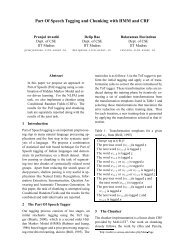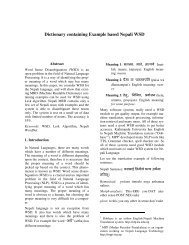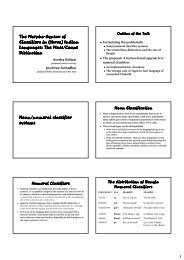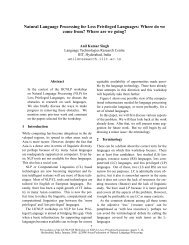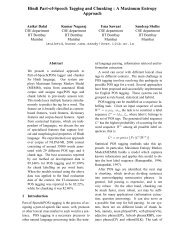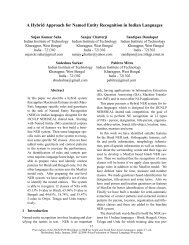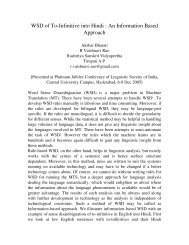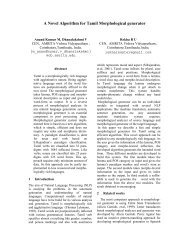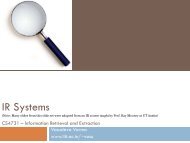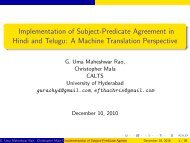SSF Format Doc - LTRC Home - IIIT Hyderabad
SSF Format Doc - LTRC Home - IIIT Hyderabad
SSF Format Doc - LTRC Home - IIIT Hyderabad
You also want an ePaper? Increase the reach of your titles
YUMPU automatically turns print PDFs into web optimized ePapers that Google loves.
<strong>SSF</strong>: Shakti Standard <strong>Format</strong> Guide<br />
Akshar Bharati<br />
Rajeev Sangal<br />
Dipti M Sharma<br />
Language Technologies Research Centre<br />
International Institute of Information Technology<br />
<strong>Hyderabad</strong>, India<br />
{sangal,dipti}@iiit.ac.in<br />
30 September 2007<br />
Abstract<br />
Shakti Standard <strong>Format</strong> (<strong>SSF</strong>) is a highly readable representation for storing<br />
language analysis. It is designed to be used as a common format or common representation<br />
on which all modules of a system operate. The representation is extensible<br />
in which different modules add their analysis. <strong>SSF</strong> also permits partial analysis to<br />
be represented and operated upon by different modules. This leads to graceful<br />
degradation in case some modules fail to properly analyze a difficult sentence.<br />
<strong>SSF</strong> also helps in debugging, and allows the modules to be located on different<br />
machines, if necessary.<br />
1 Introduction...................................1<br />
2 Text Level <strong>SSF</strong>.................................3<br />
2.1 Background................................3<br />
2.2 Examples..................................3<br />
2.3 Specifications............................5<br />
2.3.1 Text Level <strong>SSF</strong> Tags..................5<br />
2.3.2 Header...............................6<br />
2.3.3 Body Tags............................6<br />
2.3.4 Structure of Body....................6<br />
3 Sentence Level <strong>SSF</strong>.............................8<br />
3.1 Background................................8<br />
3.2 Specifications............................8<br />
4 Cross Linking of Sentences....................12<br />
4.1 Background...............................12<br />
4.2 Example..................................12<br />
References......................................13<br />
Appendix A: Example Text in CML and <strong>SSF</strong> <strong>Format</strong>s.14<br />
Appendix B:<br />
1
1 Introduction<br />
Shakti Standard <strong>Format</strong> (<strong>SSF</strong>) is a common representation for data on which all modules<br />
of a system operate. This is specially designed to keep the system architecture extremely<br />
simple.<br />
<strong>SSF</strong> allows information in a sentence to be represented in the form of one or more trees<br />
together with a set of attribute-value pairs with nodes of the trees. The attribute-value<br />
pairs allow features or properties to be specified with every node. Relations of different<br />
types across nodes can also be specified using an attribute-value like representation. The<br />
representation is specially designed to allow different levels and kinds of linguistic analyses<br />
to be stored. The developers use APIs to store or access information regarding structure<br />
of trees and attribute value pairs.<br />
If a module is successful in its task, it adds a new analysis using trees and attribute<br />
values to the representation. Thus, even though the format is fixed, it is extensible in<br />
terms of attributes or analyses. This approach allows ready made packages (such as,<br />
POS tagger, chunker, and parser) to be incorporated easily using a wrapper (or a pair<br />
of converters). In order to interface such pre-existing packages to the system, all that is<br />
required is to convert from (input) <strong>SSF</strong> to the input format required by that package and,<br />
the output of the package to <strong>SSF</strong> format. The rest of the modules of the system continue<br />
to operate seamlessly.<br />
The format allows both in-memory representation as well as stream (or text) representation.<br />
They are inter-convertible using a reader (stream to memory) and printer<br />
(memory to stream). The in-memory representation is good in speed of processing, while<br />
the stream is good for portability, heterogenous machines, and flexibility, in general.<br />
<strong>SSF</strong> promotes the dictum: “Simplify globally, and if unavoidable, complicate only<br />
locally.” However, if the number of modules is large and each module does a small job,<br />
the local complexity (of individual modules) remains under tight control for most of the<br />
modules. At worst, the complexity is introduced only locally.<br />
2 Text Level <strong>SSF</strong><br />
2.1 Background<br />
A text or document has a sequence of sentences with some structure such as paragraphs<br />
and headings. It also includes meta information related to title, author, publisher, year<br />
and other information related to origin of the text or document. Usually, there is also<br />
the information related to encoding, and version number of tagging scheme, etc. All this<br />
information is coded in <strong>SSF</strong>.<br />
The text level <strong>SSF</strong> has two parts, header and body:<br />
<br />
<br />
...<br />
<br />
<br />
2
...<br />
<br />
The header contains meta information about the title, author, publisher, etc. as contained<br />
in the CML (corpus markup language) input. The body contains sentences, each in <strong>SSF</strong>.<br />
2.2 Example for Text Level <strong>SSF</strong><br />
Here is an input example text with paragraphs and headings.<br />
The Story of My Experiments with Truth<br />
From Wikipedia, the free encyclopedia<br />
Spiritual angle<br />
In his own words Gandhi ...<br />
The spiritual angle becomes ...<br />
Here is the same text with meta tags in CML scheme. The initial set of tags encode the<br />
meta tags, and the body contains the actual text. CML <strong>Doc</strong>ument:<br />
<br />
The Story of My Experiments with Truth <br />
... <br />
<br />
http://en.wikipedia.org/wiki/The_Story_of_My_Experiments_with_Truth<br />
<br />
<br />
<br />
Spiritual angle <br />
<br />
<br />
<br />
<br />
In his own words Gandhi ...<br />
<br />
<br />
<br />
<br />
3
The spiritual angle becomes ...<br />
<br />
<br />
<br />
<br />
The above example is now shown represented in <strong>SSF</strong> with header and body. The header<br />
has the meta-tags followed by body which contains the analysis of each of the sentences:<br />
<br />
<br />
The Story of My Experiments with Truth <br />
... <br />
...<br />
<br />
http://en.wikipedia.org/wiki/The_Story_of_My_Experiments_with_Truth<br />
<br />
<br />
<br />
<br />
<br />
1 Spiritual<br />
2 angle<br />
<br />
<br />
...<br />
<br />
<br />
<br />
For full details of the above example, see Appendix A.<br />
2.3 Specifications<br />
The text level <strong>SSF</strong> has two major parts: header and body. The header has information<br />
related to origin, creation, and distribution of the text. For example, information related<br />
to title of source from which the text is taken, author name, creation date, publisher,<br />
year of publication, data entry operator, name of checker, etc. Specific tags defined for<br />
keeping each of these pieces of information are taken as they are from the corpus markup<br />
scheme CML. Please consult the relevant document for details of the scheme.<br />
The body contains the actual sentences along with paragraph structure etc.<br />
2.3.1 Text Level <strong>SSF</strong> Tags<br />
There are two tags at the outer most level: header and body.<br />
<br />
<br />
...<br />
<br />
<br />
...<br />
<br />
2.3.2 Header Tag<br />
The beginning and end of the header is marked by:<br />
and<br />
<br />
respectively.<br />
<br />
2.3.3 Body Tag<br />
The beginning and the end of the body is marked by tags:<br />
<br />
...<br />
<br />
5
The body tag has several options which indicate the encoding, and version number of<br />
sentence-level <strong>SSF</strong>. Here is an example,<br />
<br />
...<br />
<br />
Here are the details of the two options both of which are compulsory:<br />
1. encode: Encode option indicates the encoding being used for the storing the token or<br />
lexical item in the <strong>SSF</strong> (under property TKN to introduced later). Some example<br />
values are: ISCII, UNICODE, UTF-8, wx, etc.<br />
2. <strong>SSF</strong>-Version: <strong>SSF</strong>-version indicates the version being used. There are two existing<br />
versions. New versions might also come out in the future, as the standard evolves.<br />
2.3.4 Structure of Body<br />
The body of a text in <strong>SSF</strong> contains text blocks given by the tag tb.<br />
<br />
<br />
...<br />
<br />
<br />
...<br />
<br />
<br />
A text block (tb) contains a sequence of sentences. The structure of a document in text<br />
level <strong>SSF</strong> is indicated by Fig. .<br />
Figure 1: <strong>Doc</strong>ument Structure in <strong>SSF</strong><br />
Each sentence can be marked as a segment (to indicate a heading, a partial sentence,<br />
etc.) or not (to indicate a normal sentence).<br />
<br />
<br />
<br />
Spiritual angle<br />
<br />
<br />
<br />
<br />
1 In<br />
6
2 his<br />
...<br />
<br />
<br />
1 Going<br />
2 through<br />
...<br />
<br />
<br />
<br />
...<br />
<br />
<br />
7
3 Sentence Level <strong>SSF</strong><br />
3.1 Background<br />
Sentence level <strong>SSF</strong> is used to store the analysis of a sentence. It occurs as part of text level<br />
<strong>SSF</strong>. The analysis of a sentence may mark any or all of the following kinds of information<br />
as appropriate: part of speech of the words in the sentence; morphological analysis of the<br />
words including properties such as root, gender, number, person, tense, aspect, modality;<br />
phrase-structure or dependency structure of the sentence; and properties of units such as<br />
chunks, phrases, local word groups, bags, etc. Note that <strong>SSF</strong> is theory neutral and allows<br />
both phrase structure as well as dependency structure to be coded, and even mixed in<br />
well defined ways.<br />
Several formalisms have been developed for such descriptions but the two main ones in<br />
the field of NLP are Phrase Structure Grammar (PSG) and Dependency Grammar (DG).<br />
In PSG, a set of phrase structure rules are given for the grammar of a language. It is<br />
constituency based and order of elements are a part of the grammar, and the resulting tree.<br />
DG, on the other hand, is relational and shows relations between words or elements of a<br />
sentence. It, usually, tries to capture the syntactico-semantic relations of the elements in<br />
a sentence. The resulting dependency tree is a tree with nodes and edges being labelled.<br />
The difference in the two approaches are shown below with the help of the following<br />
English example:<br />
Example: Ram ate the banana. The phrase structure tree is drawn in Fig. 2 using a<br />
set of phrase structure rules. Fig. 3 shows the dependency tree representation. <strong>SSF</strong> can<br />
represent both the formats.<br />
Figure 2: Phrase structure tree<br />
Figure 3: Dependency tree<br />
Though the <strong>SSF</strong> format is fixed, it is extensible to handle new features. It also has<br />
a text representation, which makes it easy to read the output. The following example<br />
illustrates the <strong>SSF</strong>. For example, the following English sentence,<br />
Children are watching some programmes on television in the house. --(1)<br />
contains the following chunks (enclosed by double brackets),<br />
((Children)) [[are watching]] ((some programmes))<br />
((on television)) ((in the house))<br />
All the chunks are noun phrases, except for one (’are watching’) which is a verb group<br />
and is shown enclosed in square brackets. If we mark the part-of-speech tag for each word,<br />
we have the following:<br />
8
((Children_NNS)) [[are_VBP watching_VBG]]<br />
((some_DT programmes_NNS)) ((on_IN television_NN))<br />
((in_IN the_DT house_NN))<br />
The representation above is shown in <strong>SSF</strong> in Fig. 5.<br />
Address Token Category<br />
---------------------------------------------------<br />
1 (( NP<br />
1.1 children NNS<br />
))<br />
2 (( VG<br />
2.1 are VBP<br />
2.2 watching VBG<br />
))<br />
3 (( NP<br />
3.1 some DT<br />
3.2 programmes NNS<br />
))<br />
4 (( PP<br />
4.1 on IN<br />
4.1.1 (( NP<br />
4.1.2 television NN<br />
))<br />
))<br />
5 (( PP<br />
5.1 in IN<br />
5.2 (( NP<br />
5.2.1 the DT<br />
5.2.2 house NN<br />
))<br />
))<br />
---------------------------------------------------<br />
Fig. 5: Towards Shakti Standard <strong>Format</strong><br />
As shown in Fig. 5, each line represents a word/token or a group (except for lines with<br />
’))’ which only indicate the end of a group). For each group, the symbol used is ’((’. Each<br />
word or group has 3 parts. The first part stores the tree address of each word or group,<br />
and is for human readability only. The word or group is in the second part, with part of<br />
speech tag or group/phrase category in the third part.<br />
The example below shows the <strong>SSF</strong> for the first noun phrase where feature information<br />
is also shown, as the fourth part on each line.<br />
9
1 (( NP <br />
1.1 children NNS <br />
))<br />
Some frequently occurring attributes (such as root, cat, gend, etc.) may be abbreviated<br />
using a special attribute called ’af’ or abbreviated attributes, as follows:<br />
1 (( NP<br />
1.1 children NNS <br />
| | | | | |<br />
| | | | | \<br />
root | | |pers |<br />
| | | case<br />
category | number<br />
|<br />
gender<br />
The field for each attribute is at a fixed position, and a comma is used as a separater.<br />
Thus, in case, no value is given for a particular attribute the field is left blank, e.g. last<br />
two fields in the above example.<br />
The representation in <strong>SSF</strong> of sentence 1 with feature structures is given in Fig. 5<br />
(abbreviated attribute ’af’ is used).<br />
Address Token Category Attribute-value pairs<br />
-----------------------------------------------<br />
1 (( NP<br />
1.1 children NNS <br />
))<br />
2 (( VG<br />
2.1 are VBP <br />
2.2 watching VBG <br />
))<br />
3 (( NP<br />
3.1 some DT <br />
3.2 programmes NNS <br />
))<br />
4 (( PP<br />
4.1 on IN <br />
4.1.1 (( NP<br />
4.1.2 television NN <br />
))<br />
))<br />
5 (( PP<br />
5.1 in IN <br />
5.2 (( NP<br />
5.2.1 the DT <br />
5.2.2 house NN <br />
10
))<br />
))<br />
-----------------------------------------------<br />
Fig. 5: Shakti Standard <strong>Format</strong><br />
3.2 Specifications<br />
The <strong>SSF</strong> representation for a sentence consists of a sequence of trees. Each tree is made<br />
up of one or more related nodes.<br />
A node has properties which are given by prop-name and prop-val. For example, a<br />
node may have a word ’she’ associated with it along with gender ’f’. These may be stored<br />
or accessed using prop-name TKN , and gender attribute, respectively.<br />
Every node has four ”system” properties:<br />
• Address - referred to by property name ADDR<br />
• Token - acccessed by attribute name TKN<br />
• Category - accessed by attribute name CAT<br />
• Others - used to store user-defined features which are accessed through their feature<br />
names or attribute names.<br />
A property has a prop-name and prop-val.<br />
properties:<br />
Property<br />
name<br />
Example property values<br />
ADDR 1.2.4, 3.2, 2<br />
TKN ’((’, she, eating<br />
CAT NN, VB, NP, VG<br />
Here are a few examples for the system<br />
Example: Given below are two nodes (or trees with a single node each), marked by<br />
address labels 1 and 2, having their respective tokens as ’children’ and ’played’, and their<br />
categories as NN and VB:<br />
ADDR TKN CAT<br />
1 children NN<br />
2 played VB<br />
Elements in each row are separated by a single tab character.<br />
Corresponding to the above <strong>SSF</strong> text stream, an in-memory data structure may be<br />
created using the APIs. (However, note that value of the property ADDR is not stored<br />
in the in-memory data structure explicitly. It is for human reference and readability only,<br />
and is computed when needed.)<br />
Notation used for describing the values is given next. A value is given by any of the<br />
following including their combination:<br />
11
• Address. Consider the example,<br />
(.) *<br />
where < nnumber > is natural number (including zero) given by:<br />
::= *<br />
::= 0|1|2|3|4|5|6|7|8|9<br />
and where ’*’ indicates repetition zero or more times, ’(’ and ’)’ act as delimiters.<br />
• Lexical value. Consider the example,<br />
’((’ | <br />
where either the two opening parentheses or < alpha − num − tok > is present.<br />
< alpha − num − tok > is defined as follows:<br />
::= * <br />
::= _<br />
::= (|) (|)*<br />
::= A|B| ... |Z|a|b| ... |z<br />
• Category names. For the property CAT , the permissible values are given by a<br />
dictionary of terms.<br />
Property name<br />
CAT_<br />
Permitted Property values<br />
{NP,VG, ...} if CAT_ is a phrasal category<br />
{NN,JJ, ...} if CAT_ is a part of speech category<br />
The above can be written as:<br />
Property name<br />
Property value format<br />
CAT_ pcat(CAT_) -> {NP,VG, ...};<br />
lcat(CAT_) -> {NN,JJ, ...}<br />
where pcat is a procedure which gives the list of phrasal categories if value of CAT is<br />
a phrasal category, and lcat gives the list of lexical category if it is a lexical category.<br />
12
3.2.1 Attributes and Values<br />
A node may have one or more features. A feature consists of attribute-value pair.<br />
Example: Two nodes with attributes ’root’:<br />
ADDR TKN CAT OTHER<br />
1 children NN < fsroot = childnum = pl ><br />
2 played VB < fsroot = playtense = past ><br />
Note that the feature ’root’ has values ’child’ and ’play’ for the respective nodes. Similarly,<br />
features ’num’ (number) with value ’pl’ (plural), and ’tense’ with value ’past’ are also<br />
shown.<br />
To give the specification of the format of attributes and values, some definitions are<br />
introduced first::<br />
• Alpha-numeric $AN = [a-zA-ZO-9]+<br />
’[a-z]’ stands for a character out of the lower case range: ’a’ to ’z’. (In standard Unix<br />
notation for regular expressions, square brackets indicate that any of the characters<br />
is permitted, and the hyphen (’-’) shows the range. Thus, ’a-z’ means any lower<br />
case alphabetic character, etc. A ’+’ indicates one or more repetitions, whereas ’*’<br />
means zero or more repetitions.)<br />
• Alpha-numeric single-underscore:<br />
Alpha-numeric strings possibly separated by single underscores (without two underscores<br />
in a sequence and not ending or beginning with an underscore)<br />
$ANSU = $AN(_$AN)*<br />
• Alpha-numeric double-underscore: Alpha numeric single underscore strings separated<br />
by two possible double underscores<br />
$ANDU = $ANSU(__$ANSU)*<br />
Now,<br />
(i) An attribute is defined by $ANSU or $ANSU followed by underscore.<br />
::=<br />
$ANSU | $ANSU _<br />
(ii) A value is defined by $ANDU (which includes $ANSU).<br />
::= $ANDU<br />
A simple value is defined by $ANSU.<br />
Attributes<br />
There are two types of attributes - user defined or system defined. The convention<br />
that is used is that a user defined attribute should not have a underscore at the end.<br />
13
System attribute may have a single underscore at its end.<br />
Values<br />
Values are of two types: simple and structured. Simple values are represented by<br />
$ANSU. Structured values have progressively more refined values separated by double<br />
underscores. For example, if a value is:<br />
vmod__varg__k1<br />
it shows the value as ’vmod’ (modifier of a verb), which is further refined as ’varg’ (argument<br />
of the verb) of type ’k1’ (karta karaka).<br />
A value X covers another value Y, if Y is structured and more refined than X. In other<br />
words, Y is of type X, and is more specified, or refined than X.<br />
For example, a value B covers value C in the following:<br />
B = vmod__varg<br />
C = vmod__varg__k1<br />
B says that something is an argument of a verb (vmod varg), and C says that it is an<br />
argument of type k1. This indicates that C is a refined or detailed form of B.<br />
If a constraint says that the value must be of type X, then Y also satisfies the constraint.<br />
For example, if value B is constrained to be of type ’vmod varg’ then clearly both B and<br />
C satisfy the constraint. Thus, value X is covered by a value Y if the following holds:<br />
case (i): X = Y<br />
case (ii): X is a prefix of Y, followed by two underscores and $ANDU.<br />
3.2.2 Interlinking of nodes<br />
Nodes might be interlinked with each other through directed edges. Usually, these edges<br />
have nothing to do with phrase structure tree, and are concerned with dependency structure,<br />
thematic structure, etc. These are specified using the attribute value syntax, however,<br />
they do not specify a property for a node, rather a relation between two nodes.<br />
For example, if a node is karta karaka of another node named ’play1’ in the dependency<br />
structure (in other words, if there is a directed edge from the latter to the former) it can<br />
be represented as follows:<br />
1 children NN < fs drel = ′ k1 : play1 ′ ><br />
2 played VB < fs name = play1 ><br />
The above says that there is an edge labelled with ’k1’ from ’played’ to ’children’ in the<br />
’drel’ tree (dependency relation tree). The node with token ’played’ is named as ’play1’<br />
using a special attribute called ’name’.<br />
So the syntax is as follows: if you associate an arc with a node C as follows:<br />
=:<br />
it means that there is an edge from < nodename > to C, and the edge is labelled with<br />
< edgelabel >. Name of a node may be declared with the attribute ’name’:<br />
14
name=<br />
(All the words in angle-brackets may be substituted with appropriate user-defined names.)<br />
15
4 Cross Linking across Sentences<br />
4.1 Background<br />
There is a need to relate elements across sentences. A well known case is that of coreference<br />
of pronouns. For example, in the following sentences:<br />
Sita saw Ram in the house. He had come all by himself.<br />
the pronoun ’he’ in the second sentence refers to the same person as referred to by ’Ram’.<br />
Similarly ’himself’ refers to same person as ’he’ refers to. This is show by means of a<br />
coreference link from ’he’ to ’Ram’, and from ’himself’ to ’he’. <strong>SSF</strong> allows such crosslinks<br />
to be marked.<br />
The above text of two sentences is shown in <strong>SSF</strong> below.<br />
<br />
... <br />
<br />
<br />
<br />
1 Sita <br />
2 saw<br />
3 Ram<br />
4 in<br />
5 the<br />
6 house<br />
7 .<br />
<br />
<br />
1 He <br />
2 had<br />
3 come<br />
4 all<br />
5 by<br />
6 himself <br />
7 .<br />
<br />
<br />
Note that ’himself’ in sentence 2 corefers to ’he’ in the same sentence. This is shown using<br />
attribute ’coref’ and value ’he’. To show coreference across sentences, a notation is used<br />
with ’%’. It is explained next.<br />
Name labels are defined at the level of a sentence: Scope of any name label is a sentence.<br />
It should be unique within a sentence, and can be referred to within the sentence by using<br />
it directly.<br />
To refer to a name label in another sentence in the same text block (paragraph), path<br />
has to be specified:<br />
16
..\%R<br />
To refer to a name label R in a sentence in another text block numbered 3, refer to it as:<br />
..\%..\%3\%1\%R<br />
One can refer to a registered corpus C using ’ C’. This will be expanded in time to come.)<br />
5 References<br />
Bharati, Akshar, Rajeev Sangal, Dipti M Sharma, Shakti Natural Language Analyzer:<br />
<strong>SSF</strong> Representation Unpublished manuscript, <strong>LTRC</strong>, <strong>IIIT</strong> <strong>Hyderabad</strong>. (Available on<br />
http://ltrc.iiit.ac.in/ILMT)<br />
(Contains a longer description with many examples, but also with the choice of dependency<br />
structures and how <strong>SSF</strong> helps in system building is available.)<br />
17
A<br />
Example: Text in CML and <strong>SSF</strong> formats<br />
Here is an input example text with paragraphs and headings.<br />
The Story of My Experiments with Truth<br />
From Wikipedia, the free encyclopedia<br />
Spiritual angle<br />
In his own words Gandhi takes us through some of the experiences in his<br />
life, with each chapter forming at least one important learning lesson to<br />
him. Going through the introduction section of the autobiography may<br />
suggest what to expect during the five parts that follow.<br />
The spiritual angle becomes evident when Gandhi says, "...What I want to<br />
achieve - What I have been striving and pining to achieve these thirty<br />
years - is self-realization, to see God face to face, to attain Moksha<br />
(Salvation). I live and move and have my being in pursuit of this goal."<br />
Here is the same text with meta tags in CML scheme. The initial set of tags encode the<br />
meta tags, and the body contains the actual text. CML <strong>Doc</strong>ument:<br />
<br />
The Story of My Experiments with Truth <br />
<br />
Mohandas<br />
Karamchand<br />
Gandhi<br />
<br />
<br />
<br />
http://en.wikipedia.org/wiki/The_Story_of_My_Experiments_with_Truth<br />
<br />
<br />
<br />
1927<br />
<br />
<br />
Spiritual angle <br />
<br />
18
<br />
<br />
In his own words Gandhi takes us through some of the experiences in his<br />
life, with each chapter forming at least one important learning lesson<br />
to him. Going through the introduction section of the autobiography<br />
may suggest what to expect during the five parts that follow.<br />
<br />
<br />
<br />
<br />
<br />
The spiritual angle becomes evident when Gandhi says, "...What I<br />
want to achieve - What I have been striving and pining to achieve<br />
these thirty years - is self-realization, to see God face to face,<br />
to attain Moksha (Salvation). I live and move and have my being in<br />
pursuit of this goal."<br />
<br />
<br />
<br />
<br />
<br />
The above example is now shown represented in <strong>SSF</strong> with header and body. The header<br />
has the meta-tags followed by body which contains the analysis of each of the sentences:<br />
<br />
<br />
The Story of My Experiments with Truth <br />
<br />
Mohandas <br />
Karamchand <br />
Gandhi <br />
<br />
...<br />
<br />
<br />
1927<br />
<br />
<br />
<br />
<br />
1 Spiritual<br />
2 angle<br />
<br />
<br />
<br />
<br />
1 In<br />
2 his<br />
3 own<br />
...<br />
29 him<br />
30 .<br />
<br />
<br />
1 Going<br />
2 through<br />
...<br />
19 follow<br />
20 .<br />
<br />
<br />
<br />
...<br />
<br />
<br />
<br />
20
Appendix - B<br />
B<br />
Dictionary of <strong>SSF</strong> Attributes and Values<br />
B.1 Node Types<br />
Node types can be represented in the feature structure by the attribute ’ntype’. The<br />
values for the ntype attribute would be any one of the following : pos, lwg, bag, phr<br />
B.1.1<br />
pos<br />
: When the node has a part of speech as its category. Following Telugu example depicts<br />
it -<br />
(( PRP <br />
baMgArapu NN<br />
avi PRP<br />
))<br />
B.1.2<br />
lwg<br />
: a word group. For example,<br />
(( NP <br />
rAma<br />
ko<br />
))<br />
B.1.3<br />
bag<br />
: a group of words where internal dependencies are not known or are not marked. For<br />
example,<br />
(( NP <br />
My<br />
younger<br />
brother<br />
Ram<br />
))<br />
The expanded dependency tree for the above ’bag’ is given in Figure-<br />
Figure 4:<br />
21
B.1.4<br />
phr<br />
The value ’phr’ would be assigned to a phrasal node within a phrase structure paradigm.<br />
For example,<br />
(( PP <br />
to<br />
(( NP <br />
My<br />
younger<br />
brother<br />
Ram<br />
))<br />
))<br />
Although, the NP in the above example appears to be the same as the NP in the<br />
previous example (), the grammatical framework in which it is analyzed here is different.<br />
is within dependency framework and is in the phrase structure grammar framework.<br />
The expanded phrasal tree structure for the above example is represented in Figure-.<br />
Figure 5:<br />
B.2 Predicate for Dependency relation type<br />
(Note : This predicate will not be used in the ILMT system as of now)<br />
The predicate for dependency relations is ’drel’. The top level values for this attribute<br />
are - nmod, vmod, jjmod, and rbmod. Each of these values may have subtypes, particularly,<br />
vmod and nmod. Figure- and Figure- represent the subtypes for nmod and<br />
vmod respectively.<br />
Figure 6:<br />
The leaf nodes in the Figures and are the final values for the attribute ’drel’. In<br />
case the system fails to get the final value for a given node, the value of the parent node<br />
is given. For example, if the deeper level value of the drel attribute is not known for a<br />
node, a higher level value can be given. This point is further explained through Figures<br />
8 and 9 below.<br />
1. (( NP <br />
1.1 Children<br />
1.2 ))<br />
2 (( VG <br />
2.1 are<br />
2.2 watching<br />
22
))<br />
3. (( NP <br />
3.1 some<br />
3.2 program<br />
))<br />
4 (( PP <br />
4.1 on<br />
4.2 television<br />
))<br />
5. (( PP <br />
5.1 at<br />
5.2 home<br />
))<br />
Figure 8<br />
Figure 7:<br />
Figure-8 shows the fine-grained values of the drel attribute for the NPs and PPs. The<br />
NPs ’children’ and ’some program’ have the kakrak values ’k1’ and ’k2’. Both the PPs<br />
’on television’ and ’at home’ have k7p as their karaka values since both indicate ’place’.<br />
However, Figure-9 represents the drel values for both the PPs as ’ky’. This indicates that<br />
the more fine grained drel values for these PPs could not be obtained.<br />
1. (( NP <br />
1.1 Children<br />
1.2 ))<br />
2 (( VG <br />
2.1 are<br />
2.2 watching<br />
))<br />
3. (( NP <br />
3.1 some<br />
3.2 program<br />
))<br />
4 (( PP <br />
4.1 on<br />
4.2 television<br />
))<br />
5. (( PP <br />
5.1 at<br />
5.2 home<br />
))<br />
Figure 9<br />
23
The value ’ky’ indicates that the PPs are kakakas other than k1, k2 and k4. Similarly,<br />
if it is known for a node that it is a ’varg’ but not exactly which varg, the value can be<br />
given as varg and so on.<br />
Although the drel values given in Figures-5 and 6 represent the tree structure, to save<br />
typing effort, one can give only the final known value. For example, one can only give the<br />
drel value as drel=k1. All the values for the attribute ’drel’ are given in Table 1 at the<br />
end of this document.<br />
B.3 Predicate for Grammatical Role Type<br />
(Note : This is not being used in the ILMT System as of now)<br />
The attribute for the grammatical role type is ’grole’ The values for this attribute are<br />
fixed depending on the syntactic properties of a language. For example for English these<br />
values would be : Subject, Object, Object2, prep on, prep in (etc), comp that etc. The<br />
double underscore in any value indicates a subtype. For example, the value ’prep on’<br />
states ’preposition of the type on’ .<br />
B.4 Some other Predicates<br />
(Note : This is not being used in the ILMT System as of now) Certain other attributes<br />
which can occur in <strong>SSF</strong> are : Sentence Type as stype, theta roles as trel, named entities<br />
as nlp sem, sense as SID, class as CLID, Coreference as coref,<br />
24
Appendix - C<br />
C<br />
Dictionary of Categories<br />
C.1 Predicates and POS Categories<br />
Predicate is a program that returns true if the listed category is given as argument.<br />
Type Phrases/bags Lexical Head<br />
nounp NP NN,NNP,NST,PRP,WQ<br />
vrbp VGF, VGNF,VM<br />
VGINF, VGNN<br />
adjp JJP JJ,QF<br />
advp RBP RB,QF,WQ<br />
conjp CCP CC<br />
negp NEGP NEG<br />
fragp<br />
FRAGP VAUX,PSP,DEM<br />
NILp<br />
BLK SYM,INJ,UNK<br />
Predicates for the following will be decided in due course:<br />
QC, QO, RP, CL, INTF, ECH, XC, RDP, UT<br />
25



